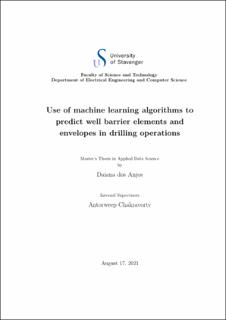| dc.description.abstract | Digitalization is a concept that have been widely approached in the oil and gas industry in the recent years. The amount of information generated in this industry is vast and the operation requirements are strict. However, the access and management of the information is still a challenge. Many tasks when planning and executing a drilling and well operation are still performed manually by the drilling and well team responsible for the field in development.
The idea proposed in this thesis is the automation of a time consuming task required on the well construction process: define the well barrier element (WBE) and well barrier schematics (WBS) for drilling operations. The idea is to explore the use of text based machine learning classification techniques applied to the text information obtained from previously available well barrier schematics from drilling operations.
Although there are software available on the market that are capable of auto-generate well barrier schematics, this application of machine learning algorithms is believed to be the first attempt. No previous studies have been identified with a similar approach. Consequently, an important contribution of this work is the database, most likely the first open database in a format that facilitate machine learning application in this area.
The experiments performed in this work started with the database creation by reading and extracting the text information from existing WBS in different file formats. Many challenges were identified during this step due to the variation in text and file formatting. After the information was extracted from the original files, text pre-process techniques were applied in the final database, resulting in a total of 1373 drilling operations WBS and over 32000 well barrier elements samples.
After the database is created, eight supervised classifiers are chosen to be evaluated on the experiment: Naive Bayes, Support Vector Machine (SVM), K-Nearest Neighbours (KNN), Decision Tree, Random Forest, Multi Layer Perceptron (MLP), a simple deep learning classifier and finally a Convolutional Neural Network (CNN) classifier.
On the experiments the samples are split in training and test based on the drilling operation WBS. A five fold cross-validation is applied for each model. With exception of the CNN classifier, a feature reduction technique is also evaluated. In the end of the experiment, five different CNN models and ten models of each of the remaining classifiers are trained and the average and best performance is compared during the evaluation.
The models are evaluated based on the correct classification of well barrier, barrier envelope and drilling operation WBS. The results show that machine learning classification can be applied to predict drilling operation WBS. Random Forest is the classifier that performed the best, achieving a maximum accuracy up to 96% for the classification of a well barrier element and 67.4% for the classification of an entire drilling operation WBS. | |
